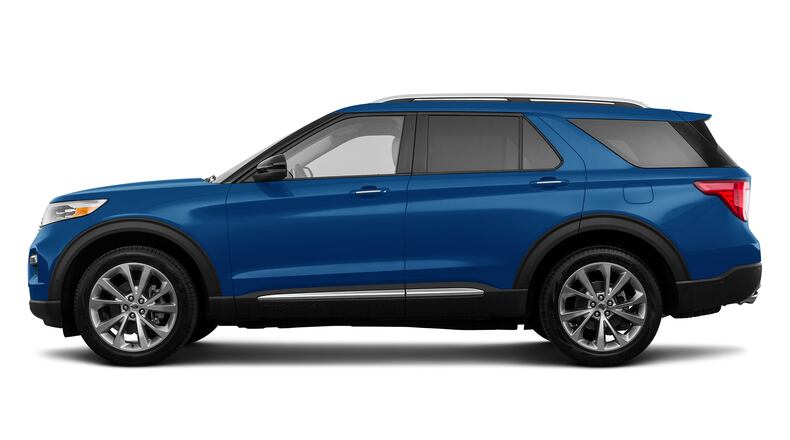The Timberline gets a Torsen limited slip rear differential, 0.8-inch increased ride height, bright orange front tow hooks and other goodies to set it apart from run of the mill Explorers.
“Ford has put all its eggs in SUVs since basically getting out of car sales,” Motor Trend Detroit Editor Alisa Priddle said. “They don’t want to leave any part of the segment untapped.”
While Jeeps traditionally offer significant off-road capability, the Timberline’s emphasis is new for the Ford Explorer.
The Explorer and the Grand Cherokee L both have three rows of seats. Three-row SUVs have traditionally been either midsize suburban family haulers or bigger Ford Expedition-type SUVs with cavernous interiors and lots of towing capacity.
The Timberline and Grand Cherokee L arrive as automakers strive to make their SUVs stand out in a crowd of three-row family models that includes the Chevrolet Traverse, Honda Pilot, Nissan Pathfinder and Toyota Highlander.
“People are doing more outdoorsy (things) in response to the COVID-19 pandemic,” Auto Trader executive analyst Michelle Krebs said. “The Explorer Timberline plays into that lifestyle.”
2021 Ford Explorer Timberline features
—All-wheel drive
—Hill descent control
—LED fog lights
—Adaptive cruise control
—Lane centering
—Speed limit sign recognition
—360-degree camera
—Front and rear skid plates
—Front tow hooks
—18-inch gloss black aluminum wheels
—Bridgestone Dueler all-terrain tires
—Tangerine accent stitching and interior trim
—Timberline badges on wheels and C-pillars
—Heated front seat and steering wheel
—5,300-pound towing capacity
Torsen rear differential improves traction
Ford expects that demand for off-road-capable vehicles will last well after pandemic restrictions lift. The company kept expectations manageable for the Timberline’s off-road capability, however, referring to it as a vehicle for rutted dirt roads and carrying mountain bikes to trailheads.
The most significant mechanical change is the Torsen limited slip rear differential for low-traction conditions. In keeping with the Timberline’s bid for off-road credibility, Ford calls it four-wheel drive, but the system is otherwise mechanically the same as the one Ford bills as all-wheel drive in other Explorers. It does not have the separate low range of gears common in vehicles designed for extreme off-roading.
There’s no rule controlling how automakers use all-wheel drive and four-wheel drive, but many buyers associate 4WD with greater off-road capability.
The Timberline’s system has seven modes, with settings like “trail” and “deep sand/snow.”
Standard hill descent control allows the driver to set a speed between 2 and 12 mph and let the Timberline’s brakes and engine maintain it while going down steep slopes. The idea is to let the driver concentrate on avoiding rocks and trees while the SUV creeps down steep slopes.
The Timberline does not offer the “trail control” feature some SUVs offer to allow electronics to similarly maintain a set forward speed while crawling over extreme terrain.
Power comes from a turbocharged 2.3L four-cylinder engine that produces 300 horsepower and 310 pound-feet of torque. It’s linked to a 10-speed automatic transmission.
More Timberline models to come
Ford retuned heavy-duty shock absorbers developed for the Explorer police interceptor and retuned the steering for off-road conditions.
New front and rear fascias — the bumpers’ cosmetic covers — along with the increased ride height, new wheels and tires contribute to greater approach, breakover and departure angles than other Explorers. Two front tow hooks can support 150% of the vehicle’s maximum loaded weight, front and rear skid plates.
A Class III tow package and 5,300-pound towing capacity are standard.
The Explorer Timberline’s EPA fuel economy rating is an estimated 19 mpg in the city, 23 on the highway and 21 combined. The combined figure is 2 mpg lower than non-Timberline Explorers with AWD and the same engine.
The interior gets unique materials and trim, including a “stone mesh” applique on the dash and tangerine contrast stitching. Rubber floor liners and easy to clean upholstery with ActiveX synthetic leather and cloth inserts are standard.
“Many people buy vehicles because they like the idea of capability,” Motor Trend’s Priddle said. “Ford is obviously planning to expand the Timberline name to other vehicles.”
Mark Phelan is the Detroit Free Press auto critic. He can be reached at mmphelan@freepress.com.
About the Author

